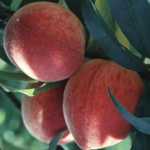Study Shows Peaches, Plums, Nectarines Fight Obesity

Peaches, plums, and nectarines have bioactive compounds that can potentially fight-off obesity-related diabetes and cardiovascular disease, according to new studies by Texas AgriLife Research.
The study, which will be presented at the American Chemical Society in Philadelphia, PA this August, showed that the compounds in stone fruits could be a weapon against “metabolic syndrome,” in which obesity and inflammation lead to serious health issues, according to Dr. Luis Cisneros-Zevallos, AgriLife Research food scientist.
Stone fruits, such as nectarine, have been shown to have many health benefits in studies at Texas AgriLife Research.
“In recent years obesity has become a major concern in society due to the health problems associated to it,” said Cisneros-Zevallos, who is also an associate professor at Texas A&M University. “In the U.S., statistics show that around 30% of the population is overweight or obese, and these cases are increasing every year in alarming numbers.”
While he acknowledged that lifestyle, genetic predisposition, and diet play a major role in one’s tendency toward obesity, “the major concern about obesity is the associated disease known as metabolic syndrome.
“Our studies have shown that stone fruits – peaches, plums, and nectarines – have bioactive compounds that can potentially fight the syndrome,” Cisneros-Zevallos said. “Our work indicates that phenolic compounds present in these fruits have anti-obesity, anti-inflammatory, and anti-diabetic properties in different cell lines and may also reduce the oxidation of bad cholesterol LDL which is associated to cardiovascular disease.”
What is unique to these fruits, he said, is that their mixture of the bioactive compounds work simultaneously within the different components of the disease.
“Our work shows that the four major phenolic groups – anthocyanins, clorogenic acids, quercetin derivatives, and catechins – work on different cells – fat cells, macrophages, and vascular endothelial cells,” he explained. “They modulate different expressions of genes and proteins depending on the type of compound.
“However, at the same time, all of them are working simultaneously in different fronts against the components of the disease, including obesity, inflammation, diabetes, and cardiovascular disease,” he explained.
Cisneros-Zevallos said this is believed to be the first time that “bioactive compounds of a fruit have been shown to potentially work in different fronts against a disease.”
“Each of these stone fruits contain similar phenolic groups but in differing proportions so all of them are a good source of health promoting compounds and may complement each other,” he said, adding that his team plans to continue studying the role of each type of compound on the molecular mechanisms and confirm the work with mice studies.
The studies on the health benefits of stone fruit are funded by the California Tree Fruit Agreement (which recently ceased operation) the California Plum Board, the California Grape and Tree Fruit League and the Texas Department of Agriculture. The Cisneros-Zevallos lab team in this study included Freddy Ibanez, Paula Castillo, Paula Simons and Dr. Congmei Cao.










